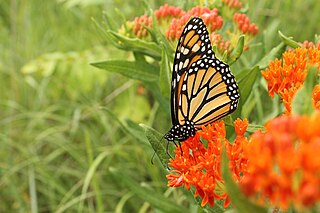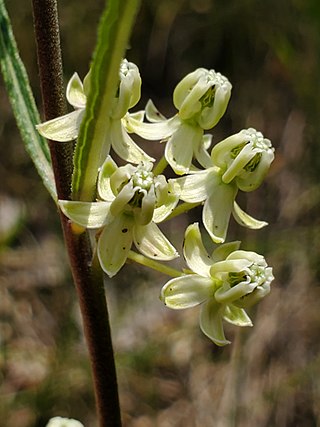
Asclepias tuberosa, commonly known as butterfly weed, is a species of milkweed native to eastern and southwestern North America. It is commonly known as butterfly weed because of the butterflies that are attracted to the plant by its color and its copious production of nectar.

The monarch butterfly or simply monarch is a milkweed butterfly in the family Nymphalidae. Other common names, depending on region, include milkweed, common tiger, wanderer, and black-veined brown. It is amongst the most familiar of North American butterflies and an iconic pollinator, although it is not an especially effective pollinator of milkweeds. Its wings feature an easily recognizable black, orange, and white pattern, with a wingspan of 8.9–10.2 cm (3.5–4.0 in). A Müllerian mimic, the viceroy butterfly, is similar in color and pattern, but is markedly smaller and has an extra black stripe across each hindwing.

Asclepias is a genus of herbaceous, perennial, flowering plants known as milkweeds, named for their latex, a milky substance containing cardiac glycosides termed cardenolides, exuded where cells are damaged. Most species are toxic to humans and many other species, primarily due to the presence of cardenolides. However, as with many such plants, some species feed upon them or from them. The most notable of them is the monarch butterfly, which uses and requires certain milkweeds as host plants for their larvae.

Asclepias syriaca, commonly called common milkweed, butterfly flower, silkweed, silky swallow-wort, and Virginia silkweed, is a species of flowering plant. It is native to southern Canada and much of the United States east of the Rocky Mountains, excluding the drier parts of the prairies. It is in the genus Asclepias, the milkweeds. It grows in sandy soils as well as other kinds of soils in sunny areas.

Asclepias incarnata, the swamp milkweed, rose milkweed, rose milkflower, swamp silkweed, or white Indian hemp, is a herbaceous perennial plant species native to North America. It grows in damp through wet soils and also is cultivated as a garden plant for its flowers, which attract butterflies and other pollinators with nectar. Like most other milkweeds, it has latex containing toxic chemicals, a characteristic that repels insects and other herbivorous animals.

Butterfly gardening is a way to create, improve, and maintain habitat for lepidopterans including butterflies, skippers, and moths. Butterflies have four distinct life stages—egg, larva, chrysalis, and adult. In order to support and sustain butterfly populations, an ideal butterfly garden contains habitat for each life stage.

Asclepias asperula, commonly called antelope horns milkweed or spider milkweed, is a species of milkweed native to the Southwestern United States and northern Mexico.

Asclepias curassavica, commonly known as tropical milkweed, is a flowering plant species of the milkweed genus, Asclepias. It is native to the American tropics and has a pantropical distribution as an introduced species. Other common names include bloodflower or blood flower, cotton bush, hierba de la cucaracha, Mexican butterfly weed, redhead, scarlet milkweed, and wild ipecacuanha.

Asclepias purpurascens, the purple milkweed, is a herbaceous plant species. It is in the genus Asclepias, making it a type of milkweed. It is native to the Eastern, Southern and Midwestern United States similar to the range of the common milkweed. The plant gets its name from the flowers that first develop a pink color but then turn darker purple as they mature. Unlike common milkweed, purple milkweed prefers some shade and is considered a plant of partial shade. It is also considered an indicator of oak savanna, especially in Wisconsin. The species rarely produces seed pods which are smooth, instead of the rough warty ones produced by common milkweed.

Asclepias verticillata, the whorled milkweed, eastern whorled milkweed, or horsetail milkweed, is a species of milkweed native to most of eastern North America and parts of western Canada and the United States.

Asclepias speciosa is a milky-sapped perennial plant in the dogbane family (Apocynaceae), known commonly as the showy milkweed and is found in the western half of North America.

Asclepias cryptoceras is a species of milkweed known by the common names jewel milkweed, pallid milkweed, Humboldt Mountains milkweed, and cow-cabbage. It is native to the Great Basin of western North America, where it grows in many types of habitat, especially dry areas. This is a perennial herb growing low against the ground or drooping. It arises from a fleshy, woody rhizome-like root. The thick leaves are round to heart-shaped and arranged oppositely on the short stem. The inflorescence is a cluster of small flowers with centers of bright to dull pink hoods surrounded by pale-colored reflexed corollas. The fruit is a follicle held erect on a small stalk.

Asclepias meadii is a rare species of milkweed known by the common name Mead's milkweed. It is native to the American Midwest, where it was probably once quite widespread in the tallgrass prairie. Today much of the Midwest has been fragmented and claimed for agriculture, and the remaining prairie habitat is degraded.

Asclepias viridis is a species of milkweed, a plant in the dogbane family known by the common names green milkweed, green antelopehorn and spider milkweed. The Latin word viridis means green. The plant is native to the midwestern, south central and southeastern United States, as well as to the southeastern portion of the western United States.

Asclepias sullivantii is a species of flowering plant in the milkweed genus, Asclepias. Common names include prairie milkweed, Sullivant's milkweed, and smooth milkweed. It is native to North America, where it occurs in the central United States and Ontario in Canada.

Asclepias hirtella, commonly called the tall green milkweed, is a species of flowering plant in the milkweed genus and dogbane family (Apocynaceae). It is native to Canada and the United States, where its range is concentrated in the Midwest and Upper South.

Asclepias stenophylla is a species of flowering plant in the dogbane family (Apocynaceae) commonly called slimleaf milkweed and narrow-leaved green milkweed.

Asclepias angustifolia, commonly called the Arizona milkweed, is an endemic species of milkweed native only to Arizona.

Asclepias perennis, also known as aquatic milkweed or white swamp milkweed, is a North American species of milkweed that is found throughout the Coastal Plain from eastern Texas to southern South Carolina, northward along the Mississippi River, and into the Ohio Valley of Illinois, Indiana, and Kentucky. There seems to be a few disjunct populations in Arkansas, Texas, and Indiana.

Asclepias cinerea, also known as Carolina milkweed or ashy milkweed, is a herbaceous perennial plant species in the genus Asclepias. It is native to the United States where its range is concentrated in the Southeast.





















